Natural building materials are currently very popular. After a brief peak in popularity, linoleum leaves the stage, again giving way to laminate and wood, since wooden floors are beautiful and durable, can have any shade and at the same time preserve the natural pattern of the material, moreover, wood is environmentally friendly and safe. Therefore, do not rush to get rid of the old parquet and even from a scratched plank floor.
Of course, you will have to spend more efforts on putting it in order than laying linoleum, but after repair, your old wooden floor will please you with its beauty for a long time to come.
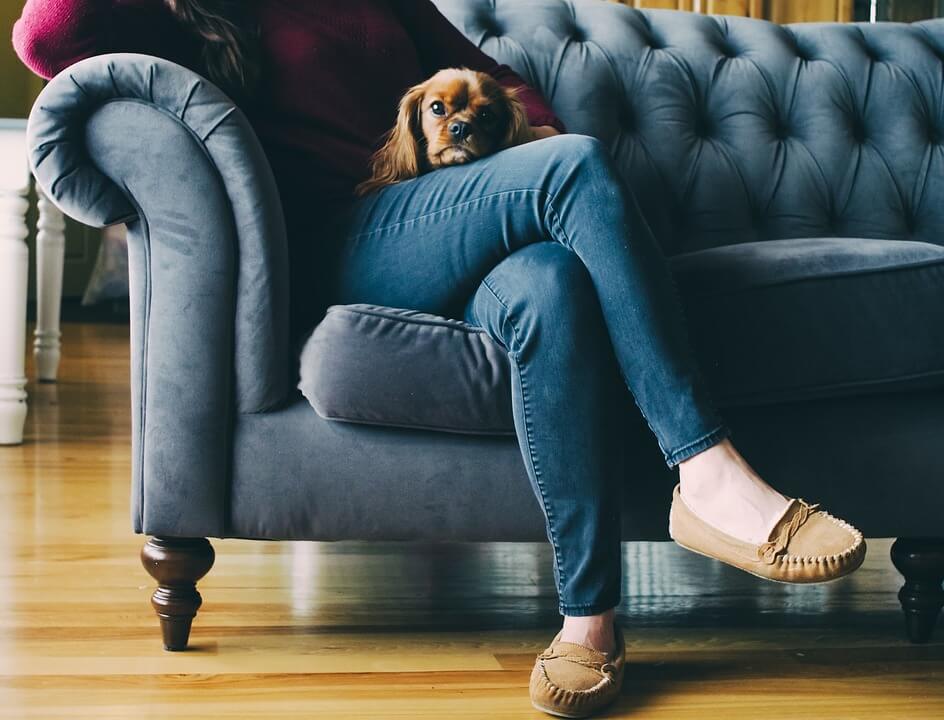
Wood flooring
To preserve the spoilage, wooden floors are often covered with varnish, wax or other protective agent, revealing the natural pattern of wood. Before varnishing, bumps must be carefully removed and sanded well (this process is also called scraping).
In addition, slight differences in height inevitably appear when laying even new boards or parquet elements, and boards in the floor, which has been used for more than one year, sag or move relative to each other.

Do not sand the floor if:
- the gaps between its elements turn out to be more than 0.7 cm. If the gap is too large to fill it with sealant or putty, the floor must be sorted out, replacing damaged elements or sealing it with bars;
- in those areas of the coating that were used most often, defects appeared with a depth of more than 4 mm. To grind the rest of the floor at this level, you will have to destroy most of the useful thickness of the boards. In this case, it would be better to simply replace these areas;
- if fragments of the floor are swollen from water, moldy or rotten. The structure of the wood is damaged, it cannot be polished, damaged areas also need to be replaced.
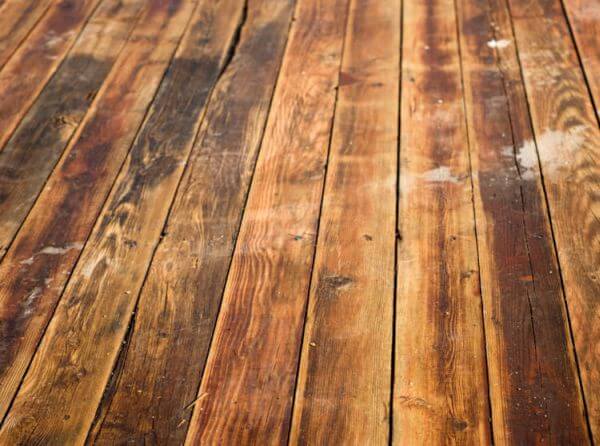
Sanding Methods
There are two ways to sand the floor: manualy and machine.
The manual sanding method is mainly used in small areas, since it is a very time-consuming job. In addition, in this way it will not be possible to obtain a truly even surface over the entire floor area.
The machine method is suitable for any object, however, the purchase of a special grinding machine is an expensive enterprise.
If you have a one-time job, you should consider renting it.
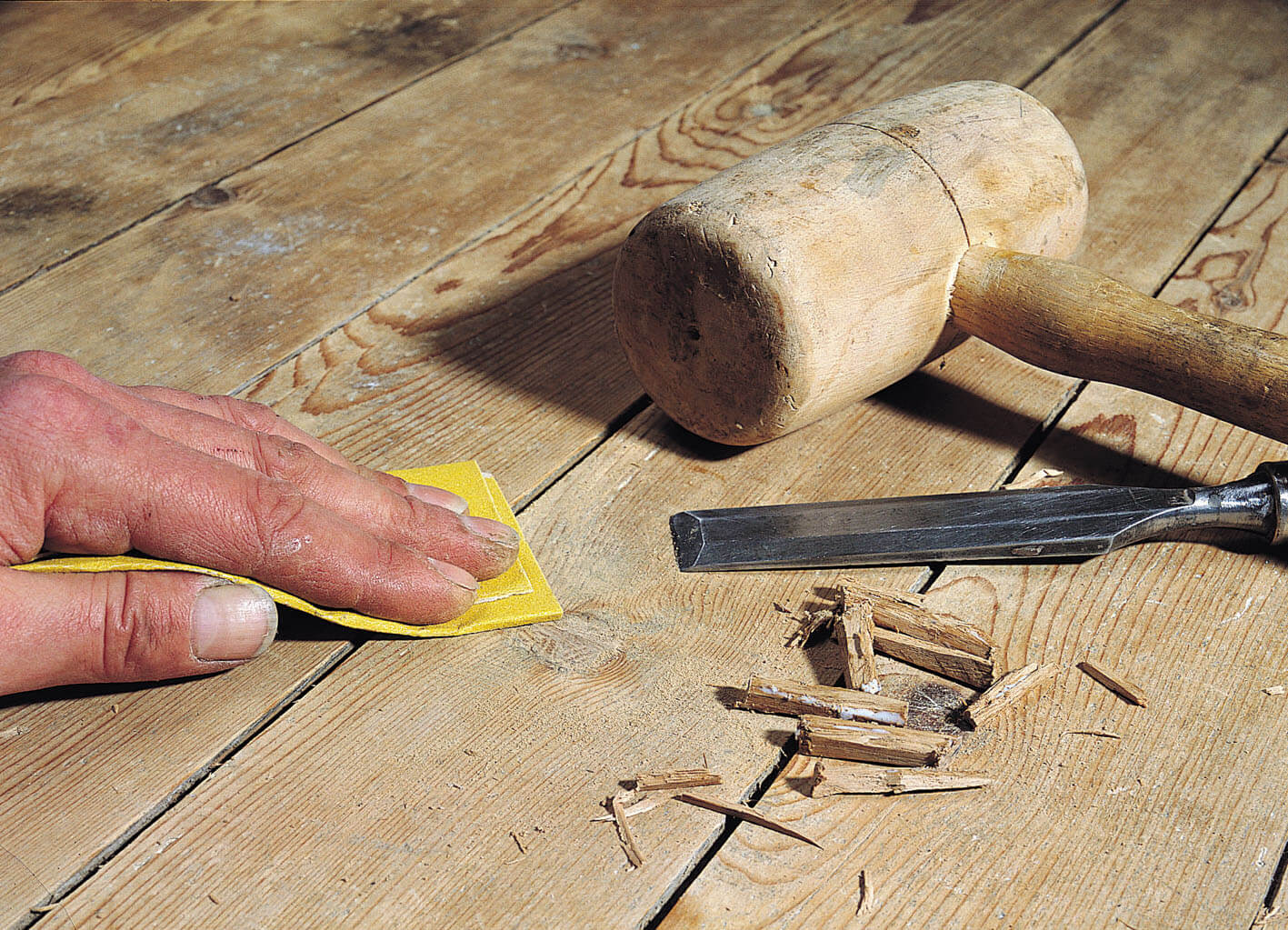
In order to sand the floor manually, you will need:
- Emery paper with a granularity from 40 to 120 units. The amount you have to determine yourself, depending on the floor area and its degree of contamination.
- A grater that is charged with sandpaper. Depending on the amount of work, you can use an inexpensive plastic product, or spend money on quality – with a wooden or rubberized handle.
- You will also need a manual cycle-scraper – a metal plate bent at an angle of 45 degrees and fixed in a wooden or plastic handle – to clean off the remnants of the old protective coating (paint, varnish) and major defects.
Types of Wood Sanders
To sand the floor using electric wood sanders, you need to imagine what type of machine you are looking for.
So, sanding machines are of the following types:
- Drum. This is a machine for the initial rough surface treatment. The same machines are used if the sanding floor is laid from large boards. The advantage of drum machines is that they can be used to process a large wooden floor. Its use is limited by the fact that it is very difficult to achieve perfect evenness of the machined surface when using such a machine – due to uneven grinding even an experienced craftsman cannot withstand the entire surface on a single level. The principle of the machine is that a piece of emery tape of the desired length is installed on one cylindrical shaft-drum.
Machines of this type are presented on the market quite widely in the price range from R750 to R12 thousand rand, but the price of professional models can reach up to R150 thousand. They are almost always equipped with a dust bag or can be equipped with an adapter for a construction vacuum cleaner.

- The belt sander. It differs from the previous type in that the working element is an abrasive tape that rotates between two rollers. The machine itself can move forward, but it is designed for initially even floors – because of the long and direct working element, the buried part of the floorboard may not be covered by the treatment.
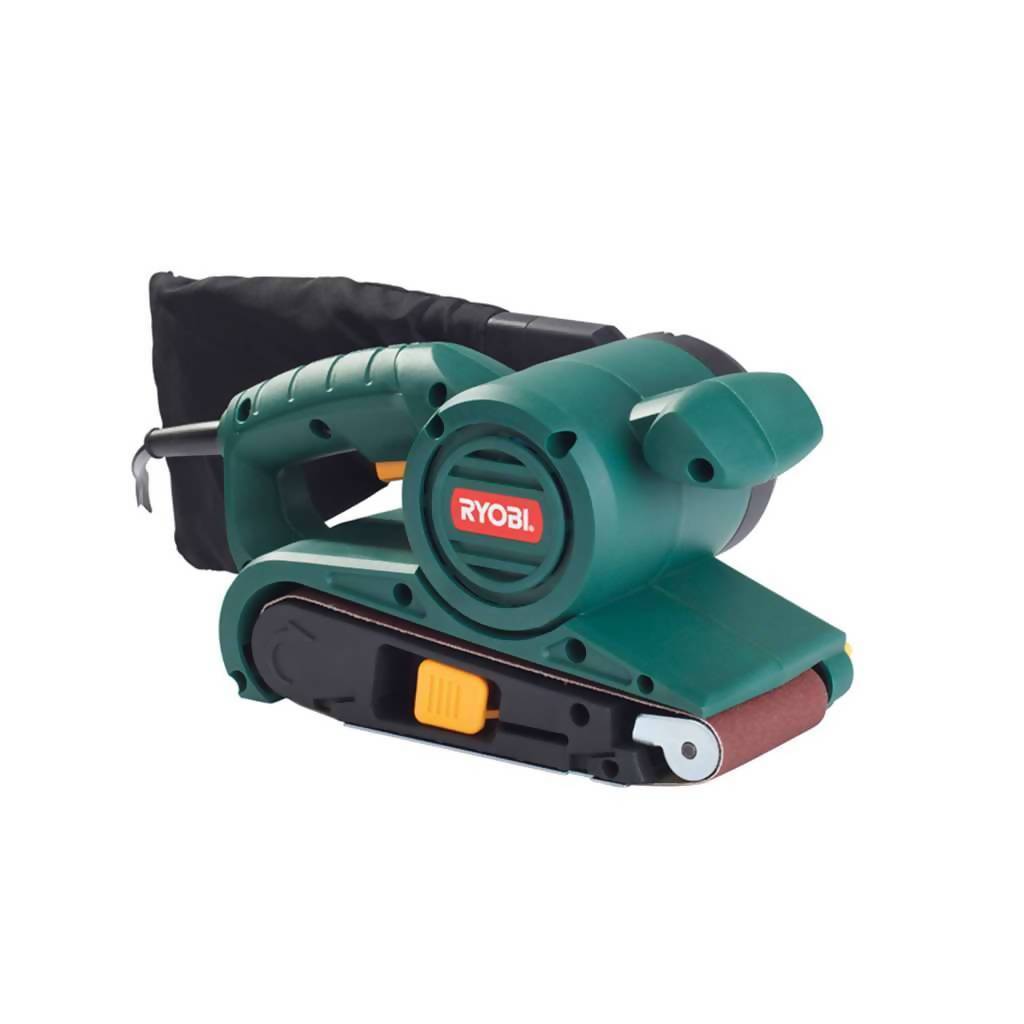
- Surface sanding or disc machine. Unlike the drum, it leaves behind a perfectly flat surface. Designed for finishing and for work from the very beginning, if you are polishing parquet flooring, recruited from small elements. This type of machine is equipped with an abrasive wheel (several wheels) with a grain size of 100 to 340 units. Professional machines can be equipped with a floating landing system for grinding heads, which allows you to literally polish the surface. Like other sanders, these models can be equipped with a vacuum cleaner.
- Angle grinders. Apparatuses of this type are popularly called a grinder. Being equipped with a petal nozzle, they can cope with a fairly large amount of work. Also in this class are orbital and vibration (operating due to the translational movements of the working element) polishers. If you are going to restore the old plank floor, the boards in which are severely deformed, you will need a more “serious” technique, such as a drum looper.
What should I look for when buying a sander?
In addition to evaluating usability, you should definitely look at the quality of the machine: the surface should be free of chips and bumps. Be sure to check the reliability of the fasteners. You should also not use low-quality cheap grinding discs and nozzles: damage to the moving parts of the machine during operation is fraught with serious injuries.
Note that it is difficult for an inexperienced master to process a large floor area with a low-power household class machine without height differences, if he does not have a solid hand and a good eye.
In addition to these units, it is worth buying or renting a construction vacuum cleaner, abrasive wheels, belts and nozzles, scissors, plastic film, and everything else that you may need in your work.
Please do not forget about goggles and a respirator. They must be worn during operation. Fine wood dust is very insidious, so you can not do without these products. You will also need protective gloves. To protect not only the respiratory system, but also the body from dust, you can use a painting suit.
In addition, when working with a looping machine, you will need headphones or earplugs to protect your hearing.
Operating procedure
Stage One: Foundation Preparation
First, all the furniture is removed from the room and the old baseboards are dismantled. It is necessary to remove all the old protective coating: in the subsequent process of hinging it will be removed in any case, but partially the floor can be cleaned already at the preparatory stage by wiping it from varnish or mastic with a sponge moistened with white spirit.
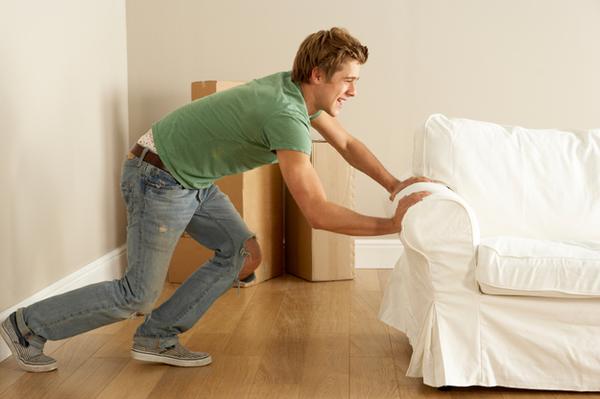
Pay attention to the fasteners protruding from the floor – all nails or self-tapping screws must be drowned into the floor to a depth of at least 2-3 mm so that they do not damage the moving parts of the grinder, which can be dangerous.
Replace all damaged strips and fix those floor elements that do not hold well, if any: this can be done with PVA glue or hardware. Carefully check the boards for loose knots, chips and gaps, if necessary, use parquet glue or special putty compounds to eliminate defects. Do not use elastic sealants before grinding – they are not strong enough and can quickly “clog” the grinding nozzle.
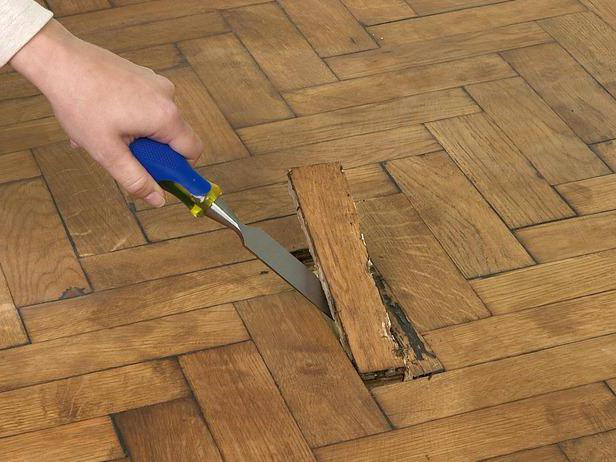
Please note that the grinding machine dusts a lot even if there is a special dust collector, therefore it is necessary to close the doorways with a cloth (non-woven material) that can be moistened to more effectively catch dust, or with plastic wrap. Windows and external doors are best opened so that some of the dust can leave the room.
Stage Two: Initial Finishing
This stage is also called scraping, since defects, dirt, old protective coatings and so on are removed in the process. If the boards are made of solid pine or other coniferous wood, remove all drops of resin with white spirit or, for example, gasoline.
The first pass in surface grinding is most often carried out with the roughest abrasive – sandpaper with a grain size of 40 units is usually used. If the boards of the new floor are already smooth enough, you can skip this step and start with a smaller abrasive.
If, on the contrary, you restore the old plank floor, the abrasive may be larger – with a grain size of 20-24 units.
The direction of movement of the machine should coincide with the direction of the wood fibers: if the floor consists of boards laid parallel to each other, then you should move in the same direction, only the first pass is made diagonally. If the parquet is laid with a “herringbone”, then you must also move along the diagonal of the room. If the floor strips are mounted so that the wood fibers are directed in different directions – the grinder should move crosswise, without highlighting areas.
On the art floor, the direction of movement is in a spiral, from the center to the edge.

The worker should also consider the following points:
- Builders advise holding the power cord of the machine on the shoulder – to avoid damage to it by moving parts of the device.
- The abrasive element must be changed after each pass, as it is abraded and clogged with dust, between the passes.
- Turning the machine engine on and off is necessary in motion, otherwise noticeable marks will remain on the floor.
- Avoid either too much pressure or too little pressure, move as evenly as possible, avoiding delays, otherwise the machine may take off too much or simply scorch the floor due to the work element creating a high temperature at the place of delay.
- Go to the next lane is carried out so that approximately half of the circle (drum) is on the already processed surface (the stripes will pass as if “overlapping”).
- Usually, after four passes with an abrasive with a grain size of 40 units, passes are followed by thinner sandpaper of 60, 80 and 120 units of grain size. When processing a thin wooden floor, in order to eliminate the risk of damage, it is possible to exclude one passage, for example, with abrasive number 60.
- Corners and steps, if any, are sanded manually, using angle grinders or a “boot”, also sequentially – at first coarse, and then with nozzles with finer grain.
- After completion of the initial stage, it is necessary to remove all wood dust and fine suspension – thoroughly vacuum or wipe the floor with a damp cloth.
- Also note – the smallest wood dust, particles of putty and varnish are very combustible materials, and under certain conditions they can even ignite spontaneously, so do not allow the accumulation of wood dust and deposits of flammable building materials in the room: it is advisable to immediately remove dust and store varnishes, paints and putty in the other place.
Stage Three: Putty
To fill the existing cracks, defects and chips, ready-made compositions or special filler fluids are used, which are mixed with small sawdust formed during sanding of the floor: this trick allows craftsmen to obtain the composition in exactly the same color as the processed wood floor. Also, sometimes ordinary PVA glue is mixed with sawdust.
The mixture is applied with a stainless steel spatula – this helps in the process to cut off all small wood fibers that rise above the floor.
After the putty dries, the floor is again finely ground, removing excess material.
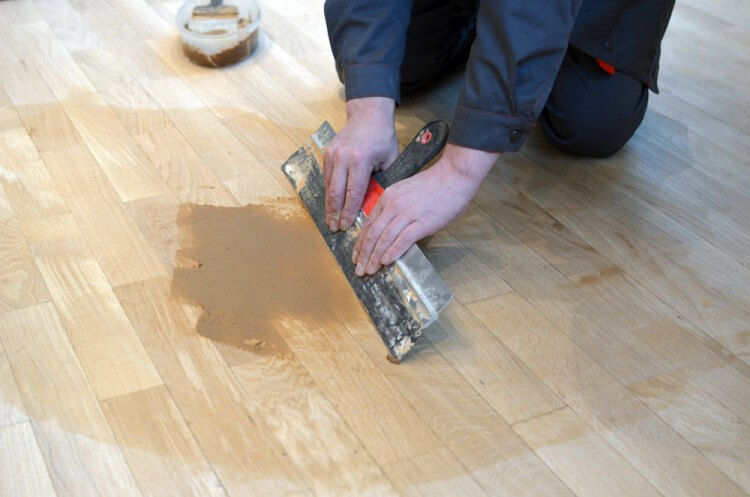
Stage Four: Finishing
Do not leave the sanded floor without a protective coating: this will lead to the fact that after a while you will have to repeat this laborious operation again.
Finishing is done after the putty has dried and cured.
Before applying the varnish, thoroughly vacuum and wash the floor: even the smallest debris will be clearly visible under a layer of clear varnish.
The floor must be treated with primers containing an antiseptic, antifungal agents or dyes. If you used a ready-made colored putty, the surface may turn out to be multi-colored, so it is still preferable to use a putty with shavings of the same wood.
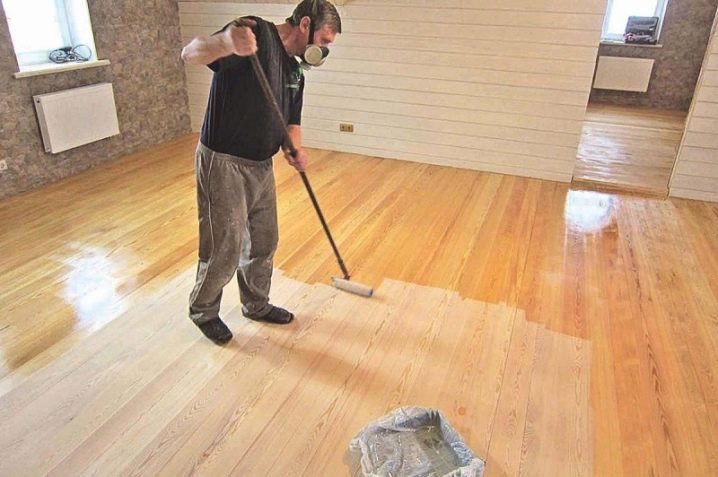
After the primer, the first layer of protective coating is applied – wax or varnish. For high-quality floor protection, it needs to be covered with an average of 5-7 layers of varnish. Depending on the operating conditions of the room, you can use acrylic, alkyd or epoxy varnish. Water-based varnishes and acrylics are almost odorless, it is impossible to say about polyurethanes.
To make the coating look homogeneous, the surface is ground every time after drying of the coating with a fine-grained (more than 140 units) abrasive, and only then is the final finishing layer of the protective coating applied.

After finishing work and drying the varnish, it is recommended to wash the floor with warm water and soap so that it is not sticky.
With a grinder, you can correctly sand the wooden floor with your own hands. A grinder is a tool that you can not only buy, but also rent.
It is worth noting that polishing the floor is an occupation that will have to spend a lot of time and effort, but this is the only way to achieve a beautiful and smooth surface on which you will be pleased to walk.

See This Video On How to Sand and Varnish Wooden Floors


